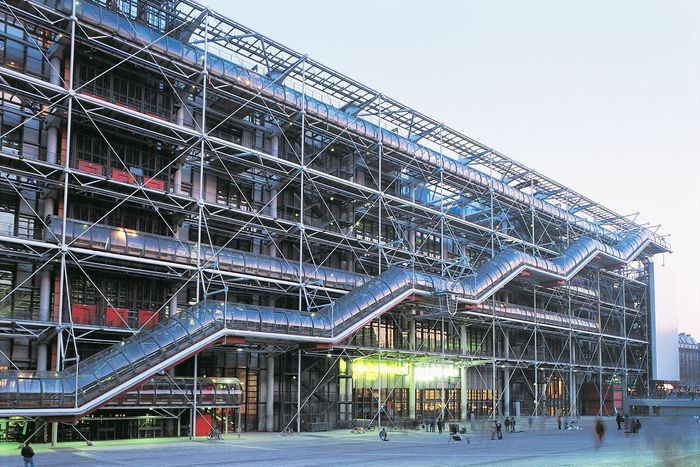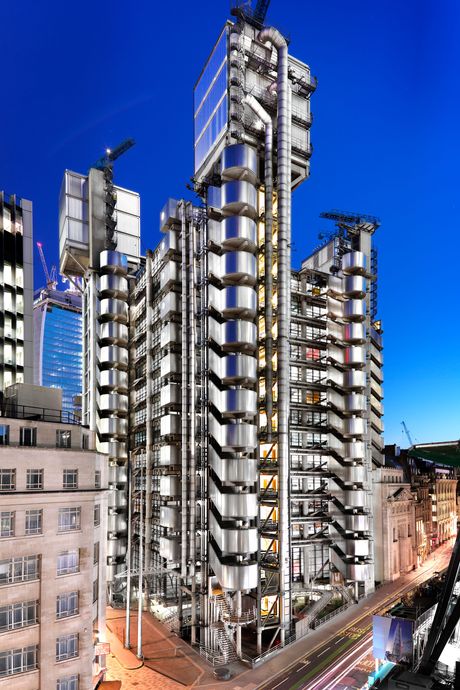
In the opening of the Slovene war novel Minuet for Guitar, the book’s protagonist, Berk, is walking along a country road on his way to join the partisan forces when he has a moment of visceral self-awareness. “How little I knew of my surroundings. And how little I knew of the planet I lived on.” In his musings, Berk veers between the serenity of nature and the horrors of the man-made world in a manic list: “Far off in the primeval forests, life followed its usual course, nature’s struggle for existence. Out in the ocean, plankton flow into the maw of the swimming whale. Air raids on cities and railway junctions. Convoys torpedoed by submarines … In a park laid waste, birds still sing … Telephones, telegraphs, communication networks, radio stations. Cries of the wounded. Community singing.” To emerge from the picturesque medieval streets of Paris and see the Centre Pompidou looming with its heady mesh of interlacing trusses and open-mouthed pipes arouses the same kind of feeling, which I can still recall many years later. This is the oeuvre of Richard Rogers, who passed away on December 18: buildings that upon first sight invoke the question, What hath mankind wrought?
Rogers, alongside Renzo Piano and Norman Foster, pioneered the style of “High Tech,” which is defined by its formal exhibition of architecture’s structural elements and necessary services in a pageant of infrastructural glee. However, unlike Piano and Foster, who later developed a more subdued modernism, Rogers never gave up on producing buildings which exhibited the structural thrills of modern engineering. He elevated the key tenet of modernism, form follows function, into a baroque frenzy in which the very functions of buildings — to remain standing, to circulate air and water and human shit and electricity — became the form itself. While buildings like the Centre Pompidou were often cited as failures for obvious reasons (putting the guts of a building on the outside where they are exposed to the elements is perhaps unwise and high-maintenance) one can claim that this was a necessary intervention in the field of architecture at the time Rogers was at his zenith, the 1970s and early ’80s.
Rogers’s work served as a reminder, at the climax of 20th century industrial modernity, that infrastructure is all around us. It girdles the country in the steel of the railways and the concrete of the interstate overpass, in the factories of Manchester and along the New Jersey Turnpike, and before those, in the suffocating mills, in the telephone and telegraph wires that blackened the sky, in the one in two linemen who died wiring New York, in the refineries that produced tetraethyl lead, in the sewers beneath the sidewalk. These things are not pretty, but they are responsible for our contemporary comforts, and in the Centre Pompidou, we are forced to confront them. One must pass through the building’s viscera to enter its sleek Taylorist factory floor for the consumption of art, which of course is also an industry. And then, when one wants to go another floor up, one must take the caterpillar-like escalators where one is reminded that we are being circulated. To catch a lovely view of Paris, one must peer through the scaffolding and be reminded that the city, too, has bowels. It’s like thinking of your small intestine every time you take a bite. Rogers was an early adopter of those elements that frighten us today — an early believer in computation, he constructed the Inmos microprocessor factory, which straddled the green landscape like a microchip soldered to a circuit board. In other works, Rogers glorified the heating and cooling systems whose refrigerants polluted communities and whose consumption of fossil fuels cook the planet. In his Patscentre building in New Jersey, the HVAC crouches over a low-slung office box, suspended by red trusses, consuming its prey like some kind of horrible insect. His work reminds us of things we’ve spent quite some time and effort making invisible.
When Rogers was working, the sins of modernity were beginning to get cleaned up. This was the time of the EPA, the Superfund project, the increased replacement of drudgery with computers, and of industry with a service economy. His postmodern contemporaries were very concerned with masking the structural with farcical homages to the past, because for them progress had finished and all that was left was nostalgia. Rogers’s elevation of services and circulation was both somewhat populist (using the quotidian to invoke the sublime) and sometimes a little too on the nose (the refinery-esque Lloyds of London is fittingly dystopian for a building which houses the grand manipulators of capitalism). Much has been written about Rogers’s failures and shortcomings both ideological and practical. Little has been said to the effect that, while deeply cool, always fantastical, and resolutely stylistic, his work is also genuinely frightening, sublime in the Burkean “pain and danger” sense — he captured the machinations of progress and the Zeitgeist of a very long industrial century when others were trying to bury Moloch beneath the earth. No other architect has ever been able to reproduce that sensation. Now we live in times where no other architect should.






